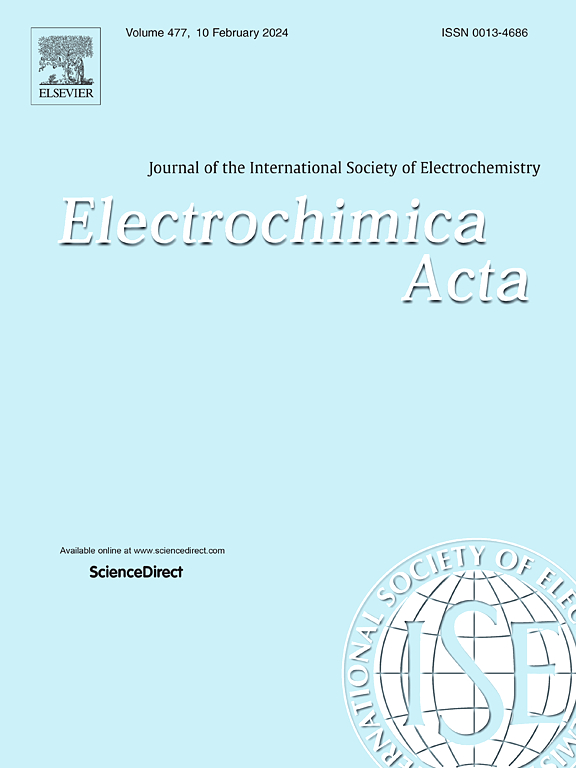特定电化学设置和阴离子类型对牙科用近中性电解液阳极氧化后氧化钛层性能的影响
IF 5.6
3区 材料科学
Q1 ELECTROCHEMISTRY
引用次数: 0
摘要
采用开路电位(OCP)、电化学阻抗谱(EIS)和动电位极化技术,在生理温度37℃下,研究了含磷酸盐、乙酸盐、硫酸盐、碘化物和硫氰酸盐的不同阴离子电解质在钛表面阳极形成的氧化层对人工唾液(AS)的耐蚀性和电化学行为的影响。我们还评估了阳极氧化参数,特别是施加电压和电流密度对这些氧化膜的影响。钛表面阳极氧化膜的恒流生长可能伴随着电解质中物质的掺入,从而影响最终氧化物的性能。与抛光钛相比,所有阳极氧化钛的OCP都转移到较小的负值。氧化层的厚度取决于氧化电位。磷酸、醋酸阳极氧化后的钛,其氧化层坚固稳定,性能一致。用硫酸盐和硫氰酸盐电解质制备的氧化物具有较高的腐蚀电流密度,特别是制备到10 VSCE的氧化物层。当TiO2达到10 VSCE时,没有明显的多孔层电阻(Rp)出现,阻挡层电阻(Rb)占主导地位,表明TiO2是致密的氧化物。当制备温度达到90 VSCE时,TiO2呈现出Rp和Rb两种结构形式,即表层为多孔,下层为致密势垒层,Rp和Rb同时存在,即表层为多孔,下层为致密势垒层。无论阴离子如何,所有电解质都产生了强阻挡层,其Rb值超过了抛光后的参考材料。在AS中孵育14天后,所有阳极氧化钛样品的OCP和腐蚀电位都明显高于抛光钛,表明在地层电压和电流密度下电化学稳定性更好。10 VSCE的电压已经产生了紧凑的保护屏障层,在更高的电流密度(25 mA/cm2)下具有稍好的稳定性。相比之下,90 VSCE产生了更厚的两层氧化物,但它们并不总是优于10 VSCE形成的致密膜。本文章由计算机程序翻译,如有差异,请以英文原文为准。
Effect of specific electrochemical settings and anion types on titanium oxide layer properties after anodization in near-neutral electrolytes for dental applications
The effect of anodically formed oxide layer on titanium using different anion namely phosphate, acetate, sulfate, iodide, and thiocyanate containing electrolytes on the corrosion resistance and electrochemical behavior in artificial saliva (AS) was investigated at physiological temperature 37°C, using open circuit potential (OCP), electrochemical impedance spectroscopy (EIS) and potentiodynamic polarization techniques. We also evaluated the impact of anodization parameters specifically applied voltage and current density on these oxide films. The galvanostatic growth of anodic oxide films on titanium can be accompanied by the incorporation of species from the electrolyte into the oxide, affecting the properties of the final oxide. OCP was shifted to less negative values for all anodized Ti compared to polished Ti. The thickness of the oxide layer was dependent on the oxidation potential. Titanium anodized with phosphate and acetate reflected robust and stable oxide layer showing consistent performance. Higher corrosion current density was measured for oxide prepared with sulfate and thiocyanate electrolytes, especially for oxide layer prepared up to 10 VSCE. When TiO2 is prepared up to 10 VSCE, no distinct porous layer resistance (Rp) appears and the barrier layer resistance (Rb) dominates, indicating a compact oxide. TiO2 shows both Rp and Rb, indicating a dual-layer structure with a porous outer layer and a dense barrier layer beneath when prepared up to 90 VSCE, both Rp and Rb are present, showing a dual‐layer structure with a porous top layer and a dense barrier beneath. Regardless of the anion, all electrolytes produced strong barrier layers with Rb values exceeding those of the polished reference. After 14 days’ incubation in AS, all anodized titanium samples exhibited significantly higher OCP and corrosion potentials than polished titanium, indicating greater electrochemical stability across formation voltages and current densities. A voltage of 10 VSCE already generated compact and protective barrier layers, with slightly better stability at higher current density (25 mA/cm2). In contrast, 90 VSCE produced thicker two-layer oxides, but these did not consistently outperform the compact films formed at 10 VSCE.
求助全文
通过发布文献求助,成功后即可免费获取论文全文。
去求助
来源期刊

Electrochimica Acta
工程技术-电化学
CiteScore
11.30
自引率
6.10%
发文量
1634
审稿时长
41 days
期刊介绍:
Electrochimica Acta is an international journal. It is intended for the publication of both original work and reviews in the field of electrochemistry. Electrochemistry should be interpreted to mean any of the research fields covered by the Divisions of the International Society of Electrochemistry listed below, as well as emerging scientific domains covered by ISE New Topics Committee.
 求助内容:
求助内容: 应助结果提醒方式:
应助结果提醒方式:


